
Is everything quiet in deep space? Not hardly. It's a place jammed with noises of all kinds. So much noise, in fact, that it could be quite difficult to pick up a faint signature of something small... something like the smallest black hole known. Thanks to NASA's Rossi X-ray Timing Explorer (RXTE) , an international team of astronomers have found the pulse they were looking for and it's a pattern that's only been seen in one other black hole system. Its name is IGR J17091-3624 and it's a binary system which consists of a normal star and a black hole with a mass that measures only about three times solar. In theoretical terms, that's right at the edge where possibility of being a black hole begins.
Here's the picture... In this binary system, escaping gas from the "normal" star flows across space in the direction of the black hole. This action creates a disk where friction heats it to millions of degrees - releasing X-rays. Periodic changes in the strength of the X-ray emissions point towards the actions taking place within the gas disk. Scientists theorize that fast changes occur at the event horizon... the point of no return.
IGR J17091-3624 was discovered when it went into outburst in 2003. Current observations have it becoming active every few years and its most recent flare began in February of this year and has been kicking up cosmic dust ever since. Observations place it in the general direction of Scorpius, but astronomers aren't sure of an exact distance - somewhere between 16,00 light years to more than 65,000. However, IGR J17091-3624 isn't absolutely alone in its unique changes. Black hole binary, GRS 1915+105, also displays a number of well-ordered rhythms, too.
This animation compares the X-ray 'heartbeats' of GRS 1915 and IGR J17091, two black holes that ingest gas from companion stars. GRS 1915 has nearly five times the mass of IGR J17091, which at three solar masses may be the smallest black hole known. A fly-through relates the heartbeats to hypothesized changes in the black hole's jet and disk. Credit: NASA/Goddard Space Flight Center/CI Lab
"We think that most of these patterns represent cycles of accumulation and ejection in an unstable disk, and we now see seven of them in IGR J17091," said Tomaso Belloni at Brera Observatory in Merate, Italy. "Identifying these signatures in a second black hole system is very exciting."
Binary GRS 1915 has some very cool characteristics. Right now astronomers have observed jets blasting out in opposite directions cruising along at 98% the speed of light. These originate at the event horizon where strong magnetic fields fuel them and each pulsation matches the occurrence of the jets. By observing the X-ray spectrum with RXTE, researchers have discovered the interior of the disk creates enough radiation to halt the gas flow - an outward wind which negates the inward flow - and shuts down activity. As a result, the inner disk glows hot and bright, eliminating itself as it flows toward the black hole and kick starts the jet activity again. It's a process that happens in as little as 40 seconds!
Right now astronomers aren't able to prove that IGR J17091 has a particle jet, but the regular pulsations indicate it. Records show this "heartbeat" occurs about every five seconds - about 8 times faster than its counterpart and some 20 times more faint. Numbers like this would make it a very tiny black hole.
"Just as the heart rate of a mouse is faster than an elephant's, the heartbeat signals from these black holes scale according to their masses," said Diego Altamirano, an astrophysicist at the University of Amsterdam in The Netherlands and lead author of a paper describing the findings in the November 4 issue of The Astrophysical Journal Letters. It's just the beginning of a full scale program involving RXTE to compare information from both black holes. Even more detailed data will be added from NASA's Swift satellite and XMM-Newton, too.
"Until this study, GRS 1915 was essentially a one-off, and there's only so much we can understand from a single example," said Tod Strohmayer, the project scientist for RXTE at NASA's Goddard Space Flight Center in Greenbelt, Md. "Now, with a second system exhibiting similar types of variability, we really can begin to test how well we understand what happens at the brink of a black hole."
Original Story Source: NASA Mission News.
No comments:
Post a Comment